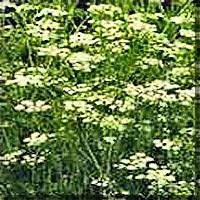
Cuminum cyminum

Cuminum cyminum
Origin - East Mediterranean
Cultivated - Iran, Turkey, India, China, Indonesia, Japan, Southern Russia, Morocco, Mexico
Description - Natural Order, Umbelliferae. Cummin is a native of Egypt, but now cultivated largely throughout Western Asia and Southern Europe. It is quite a small annual, from six to twelve inches high, with slender branches, and numerous leaves cut into narrow segments. Flowers very small and white, hidden in the bracts. Fruit a small, tapering silicle, rough, flat, furrowed, light-brownish, ridged. These seeds contain quite a large percentage of essential oil, which is of a yellow tint, and a peculiar heavy and not always agreeable smell. The seeds have the same strong aroma, and a bitterish-warm taste. Cumin seed was once widely used as a food flavouring in Europe, the Romans ground it into a powder and used it like pepper[268]. It is little used at present in Western cooking, though it is much employed in India[268]. A hot and aromatic flavour, it is an important ingredient in curries, and is also often used as a flavouring in biscuits, cakes and bread where it also helps in improving the digestion. The seed is harvested when fully ripe and is then dried and stored in airtight jars.
Parts used - Seeds.
Medicinal Uses - Antibacterial; Antispasmodic; Aphrodisiac; Carminative; Galactogogue; Poultice; Stimulant; Stomachic.
Cumin is an aromatic, astringent herb that benefits the digestive system and acts as a stimulant to the sexual organs. It has been used in the treatment of minor digestive complaints, chest conditions and coughs, as a pain killer and to treat rotten teeth. Cumin is seldom used in Western herbal medicine, having been superseded by caraway which has similar properties but a more pleasant flavour. It is still widely used in India, however where it is said to promote the assimilation of other herbs and to improve liver function.
The seed is antispasmodic, carminative, galactogogue, stimulant and stomachic. A general tonic to the whole digestive system, it is used in the treatment of flatulence and bloating, reducing intestinal gas and relaxing the gut as a whole. In India it is also used in the treatment of insomnia, colds and fevers and to improve milk production in nursing mothers. Ground into a powder and mixed into a paste with onion juice, it has been applied to scorpion stings. The herb has been used externally as a poultice to relieve stitch and pains in the side. The essential oil obtained from the seed is antibacterial and larvicidal.
Poultice for Abdominal Pain - Soak 2-1/2 tbsp. of cumin seeds in some hot water for about 2 hours. Strain and dry thoroughly before crushing them with a heavy object (clean stone or hammer or rolling pin). Then mix them in with a little white flour and hot water-just enough to form a thin paste. Add several drops of peppermint oil to the hot water before mixing in the other ingredients. Spread this mixture on a piece of muslin cloth and apply over the abdomen to relieve liver, stomach and gall bladder pains. A tea made by steeping 1 tsp. of cumin seeds in 1 pint of water for an hour helps relieve muscle spasms.
Pharmacology - Chemical components of volatile oil from Cuminum cyminum - Volatile oil was extracted from Cuminum cyminum L. by using steam distillation. More than sixty peaks were separated and 49 compounds were identified by gas chromatography-mass spectrometry (GC-MS). The relative amounts of the components were determined by area normalization method. Among the 49 compounds identified, there were 16 hydrocarbons and 32 oxygenated compounds. The main compnents were cuminal and safranal (accounting for 32.26% and 24.46% respectively in the components identified). The other nine compounds with contents all over 1%, were monterpenes, sesquiterpenes, aromatic aldehydes and aromatic oxides etc. The other components with relatively small amounts were chiefly terpenes, terpenols, terpenals, terpenones, terpene esters and aromatic compounds. It is good to separate polar and apolar components in the volatile oil from Cuminum cyminum L. on the GC capillary column of moderate polarity.